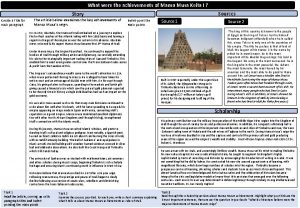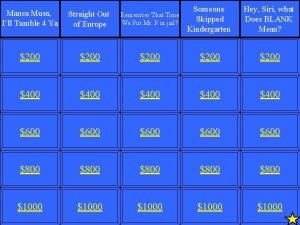What were the achievements of Mansa Musa Keita

- Slides: 1

What were the achievements of Mansa Musa Keita I ? Sources Story Create a Title for each paragraph The article below examines the key achievements of Mansa Musa’s reign. Bullet-point the Main points Source 1 Source 2 Built in 1327 reportedly under the supervision of Es-Saheli, the Djinguereber Mosque in Timbuktu became a centre of learning. Es. Saheli was given 12, 000 mithkals of gold dust(roughly $2. 7 million at today’s gold prices) for his designing and building of the mosque. The king of this country is known to the people of Egypt as the king of Tekrur; but he himself becomes indignant (offended) when he is called this, since Tekrur is only one of the countries of his empire. The title he prefers is that of lord of Mali, the largest of his states; it is the name by which he is most known. he is the most important of the Muslim Negro kings; his land is the largest, his army is the most numerous; he is the king who is the most powerful, the richest, the most fortunate, the most feared by his enemies and the most able to do good to those around him. (al Omari was a Muslim who lived in the Middle East during the reign of Mansa Musa. Twelve years after Musa had traveled through Cairo, al Omari wrote a second hand account of his visit. He interviewed many people who had lived in Cairo during Musa's visit. In addition, al Omari showed his interest in the Kingdom of Mali by interviewing a friend who had lived in Mali for thirty-five years. ) In 1312 AD, Abu Bakr, the Mansa of Mali embarked on a journey to explore the furthest reaches of the Atlantic taking with him 2000 boats and leaving a regent in charge of the empire as was the custom in his absence. Abu Bakr never returned & his regent Mansa Musa became the 10 th Mansa of Mali. Under Mansa Musa, the Empire flourished. He continued to expand the borders of Mali through military action and diplomacy, successfully extending his rule to the strategically important trading cities of Gao and Timbuktu. This enabled him to exert even greater control over the Trans-Saharan trade routes & profit from the taxation of this. The Emperor’s extraordinary wealth came to the world’s attention in 1324, when Musa performed the Hajj to Mecca. He is alleged to have taken his entire court and an entourage of 60, 000 men with him. On his way through Cairo, his giving of alms to the poor, spending in the markets and lavish giftgiving caused a financial crisis which saw the price of gold plummet-reported to be the only time in history a single individual has had such an impact on the gold economy. His arrival in Cairo caused such a stir that many Arab historians continued to write about him well after his death, with his fame spreading to Europe & his empire appearing on Maps made in Spain and Venice, cementing Mali’s reputation as a great Empire. Mansa Musa maintained excellent diplomatic ties with other North African Kingdoms and through his hajj, strengthened Mali’s connection with the Islamic world. . During his journey, Mansa Musa recruited Islamic scholars, and poets to develop Mali’s cultural and religious pedigree. Most notably, a Spanish poetturned-architect called es-Sahili. He set about transforming the cities of Mali, with es-Sahili famously building ‘The Hall of Audience’ and royal palace in Niani: a multi-storied building with wooden-framed windows covered in silver leaf and elaborate decorations. He also built the Great Mosque at Timbuktu which still stands today. The university of Sankore was re-stocked with mathematicians, astronomers and other scholars during Musa’s reign, beginning Timbuktu’s rich scholarly heritage and ensuring Islam’s continued growth in influence in West Africa. Historians believe that Mansa Musa died in 1337 after a 25 year reign. Following Mansa Musa, the prestige and power of Mali began to slowly decline following a succession of weak rulers, rebellions and diminishing control over the trans-Saharan trade routes. Task 1 Read the article, coming up with paragraph titles and bulletpointing the main points Task 2 Examine the sources provided. For each one, write a short summary explaining what it tells us about Mansa Musa’s achievements as ruler of Mali. Scholarship His primary contribution was the military incorporation of the middle Niger River region into the Kingdom of Mali through the use of cavalry forces and professional armies. In addition, his conquests ultimately led to the control and incorporation of the important mercantile centres and cities of Timbuktu and Gao, the trans -Saharan trading town of Walata and the salt mines of Taghaza to the north. During Mansa Musa’s reign the territory of Mali was doubled in size and the capture and control of the primary salt and gold producing areas of the region secured the empire’s wealth and stability. West African Empires: dates 400 -1591 C. E. Dr. Ruben G. Mendoza He was a man with no rivals, and a seemingly limitless wealth. Mansa Musa set his mind to making Timbuktu his new cultural capital. He was a radical head of state; he sought to augment his kingdom’s highly sophisticated systems of recording oral histories by encouraging the introduction of writing in Arabic. It was not something that he did by halves. He constructed his new city around a great centre of learning, with magnificent libraries, which drew large numbers of scholars into the region. Timbuktu became a prosperous centre of learning, attracting scholars and students from across West Africa and beyond. This almost fanatical focus on knowledge and historical narrative and the celebration of historians became integral to the civic and legislative models of many West African states that emerged over the following centuries – each one in its own way determined to define legitimacy through similarly strong intellectual and narrative traditions. Dr. Gus Casely-Hayford Task 3 Read through the scholarship sections about Mansa Musa’s achievements. Highlight what you think are the 3 most important sentences, then answer the question in your books “What do historians believe were the major achievements of Mansa Musa’s reign ”

